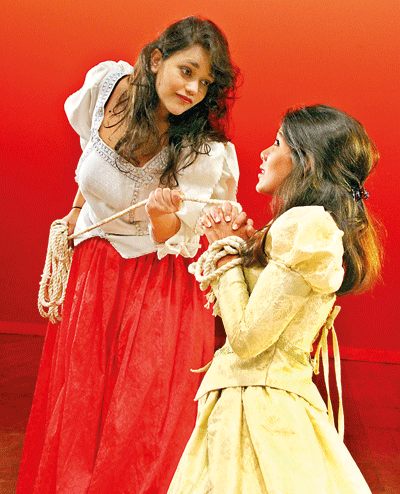A difficult balancing act

Conflict: Tasmin Anthonisz and Inaya Bongso as Kate and Bianca
Taking on The Taming of the Shrew is no mean feat because it is arguably Shakespeare’s most problematic play. Inherently a comedy, the play involves complicated gender politics with most critics still to this day trying to figure out whether it is misogynistic or not.
The eponymous ‘shrew’ – Katherina (or Kate) – is widely feared amongst the community for her assertiveness and violence in comparison to her gentler, more beautiful sister Bianca. This proves to be a challenge for some of Bianca’s suitors as her father, Baptista, proclaims that only when Kate is wed can Bianca marry. Enter Petruchio, a mischievous rascal, who takes it upon himself to ‘tame’ Kate into submission and thus produce a partnership of equals. The complex layers of the play don’t make it an easy show to put on as the lines are blurred between comedy and sexism. I was very eager therefore, to watch The Combined Theatre Company’s take on this Shakespeare classic with the experienced duo Vinodh Senadeera and DelonWeerasinghe at its helm.
The beautiful set modelled itself on the Shakespeare Globe complete with wooden balconies lining three sides of the stage with two stairs providing access to the central balcony. Hardly any stage furniture, was used which complemented the sparse lighting scheme and juxtaposed well with the bold colours of all the costumes; these were brilliantly designed and gave the audience a real feel for 16th century Verona.
From the onset, it was clear that the play would border more on farce than it would comedy with all actors portraying a more embellished version of their character complete with flouncy gestures, erratic movement, little idiosyncrasies and general buffoonery. You could often find Petruchio (Rahantha Abayakoon) darting excitedly from one point of the stage to the other, or Kate (Tasmin Anthonisz) shrieking at unexpected moments.For the most part, the interaction between all the actors was a pleasure to watch as you could see the entire cast was tight – particular mention goes to Tranio (Biman Wimalaratne) who acted as a good foil for the lovesick Lucentio(Mevantha De Silva).
Shakespearean text is not at all easy to grapple with but major props must be given to the entire cast for handling the language as if it was their common tongue. Having said that, the dialogue was often fast paced and bordered on screaming at certain points, making it incoherent and rather incomprehensible to the audience. At times, the farcical elements of the show had the capacity to become annoying if they were over-indulged; slaps were used too frequently and action on the side became too distracting. At one point Hortensio stuffs a pink dress underneath his doublet directing the focus onto him rather than on the submission of Kate which is supposed to be the central part of the scene.
In general, it was hard to pick any standout actors mostly because the characters melded into one – the boys indulged in all shades of idiotic whilst the girls were likeable enough but still feeble against their “masters”. As a result, it was difficult to invest in any character well enough to actually take them seriously. This was indeed a shame because the entire cast had tremendous potential and impeccable comic timing – but a lack of character development seemed to let them down– at times it felt too much like watching a school production.
But this being a comedy and close enough to what a 16th Century version of Taming of The Shrew would have looked like, perhaps this wasn’t the point. This raises the vexing question of whether directors have a duty to re-innovate Shakespearean texts to reflect the changing world. In short, no. Directors can do whatever the hell they want. But (there’s always a but) this is the 21st century – the text has become more nuanced and gender interaction more complex than ever. In this play, Kate vehemently opposes the marriage, is starved by Petruchio and his servants, and is emotionally manipulated into accepting her husband’s words as law. It is hard to run away from such glaring moments of abuse. It was interesting to note that during the show, Petruchio places a bowl of water in front of Kate, ostensibly for her to wash her hands but instead pushes her head into it to which half the audience laughed and the rest gasped. At another point, Kate is seen to be punching Petruchio. Arguably here, domestic abuse is passed off as comedy – though this is more a quibble with the Shakespearean text than its modern-day direction.
Vinodh and Delon, in previous interviews, have stated that the message they wanted to convey was the empowerment of women and how both Kate and Petruchio ‘sort of’ tame each other in the end but this character arc was not clear at all. From my point of view Tasmin’s Kate simply accepts Petruchio’s words, suddenly falls in love and turns into an obedient wife. This does not seem like a partnership of equals – but rather that she changed herself to fit his mould whilst he remained the same. Feminism! Equality! Yay!
As previously mentioned, The Taming of the Shrew is a tough play to put on and is at risk of being criticised either for straying too far from the original or for not tackling its deep-seated issues. In this context, the directors had no obligation to take on a deeper reading of the text. As a comedy which bordered more on farce, this production worked well enough but as it is an already over-explored genre in the Colombo theatre scene, it does feel like they missed an opportunity to do something more complex and ultimately more interesting with this play.


